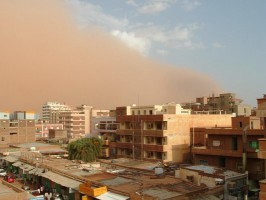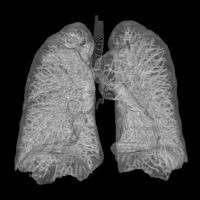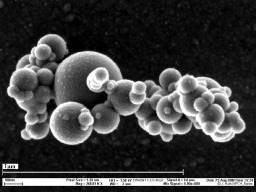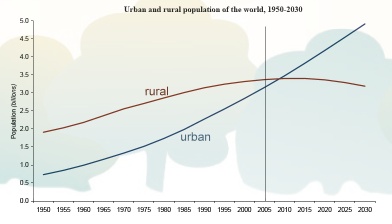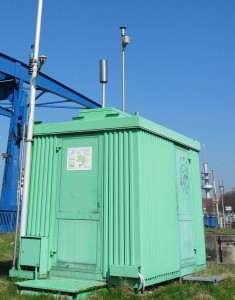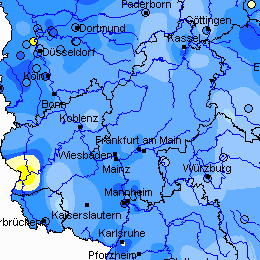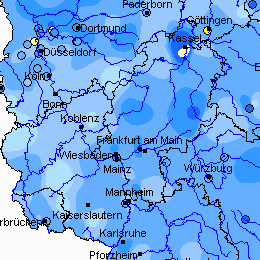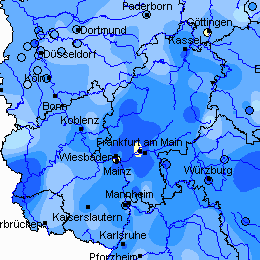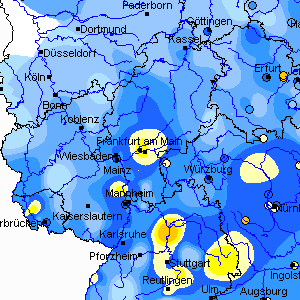 > ACCENT en > UQ 1 Nov Dec 06 Particles in air > Introduction
> ACCENT en > UQ 1 Nov Dec 06 Particles in air > Introduction
|
IntroductionAerosols and particulate matter* in the airParticles are suspended everywhere in our air. We call them aerosol. This means matter "solved in air". Such particles can be solid or liquid, but we exclude water from the definition. |
|
Particles have an impact on our health, since we inhale them when we breathe. In particular the health burden, for example in busy streets, has been investigated recently. We estimate now that its relevance is higher than we thought before. This has led to a discussion about tolerable limit values and the protection of citizens. 2. Image on the left: Computer tomographic image of the lungs. Source: Andreas Heinemann / Zeppelinzentrum Karlsruhe (GNU licence, Wikipedia) |
3. Many particles are smaller than 10 µm. Here you see an electron-microscope image of an aerosol particle about 1 µm in diameter from the Mediterranean; Image: Joachim Huth, MPI Mainz
|
|
|
The burden in urban air According to estimations of the United Nations about half of the world population is living in urban areas in 2007 (3.3 billion of 6.6 billion people). |
|
The share of the urban population has increased in absolute and relative numbers significantly by about 30% since 1950 (0.77 of 2.56 billion people) and may reach the 60% level in 2030. In cities we are exposed to more exhaust gases than in rural areas.
|
Among them are sometimes very toxic compounds like polyaromatic hydrocarbons or heavy metals, which appear locally in high concentrations coming from defined sources. However, ozone, nitrogen oxides and particles are present nearly everywhere and widespread. Those responsible for air quality policy have passed many laws and guidelines on a local, national and international scale in order to limit the emission of pollutants and improve air quality. But in particular for particles such measures are controversial and advice from science is welcome.
|
|
|
The problem of limit values Health problems arising from particles are a problem for legislation. This is for two reasons: |
|
The established laws for air quality control arrange limit values which are not to be exceeded. It is possible to measure the particle mass but it is not reasonable to define for particles a total mass in one cubic metre of air which should not be exceeded. Small particles may have mass a million or billion times smaller than large ones and they can be dangerous while the large ones are not. A chemical analysis of the particle composition would be necessary in order to estimate the real health risk, but it is too complicated for routine measurements at air quality control stations. Therefore we cannot differentiate between dangerous and harmless particles of similar size. In the European Union tightened guidelines for "inhalable particulate matter" have been valid since 2005. In many cities the daily average limits of 50 µg/m3 (PM 10) have been exceeded too often, i.e. more than 35 times in a year. |
|
Since the EU limit values of PM 10 define a maximum mass per volume of air in this size range, large particles are excluded but nevertheless it cannot be concluded from an exceedance which health dangers are really caused. The following maps show typical measurement values (daily average) in Germany and demonstrate also changes from one day to the other. Values in the blue range are below the limit of 50 µg/m3, yellow and red above.
|
|
|
|
|
|
The following values from 15.12.2006 demonstrate that high PM 10 burdens often appear in urban areas but can also appear in rural regions. |
|
|
|
Both are of interest for research, health questions and definition of limits as well as the influence of particles on the local and global climate. For this, it is necessary to gain a deeper understanding of where particles come from, how they behave in the air, what they consist of and what influences they are subject to. In this and the following magazines we are going to explain the basics of this step by step.
|
* For particulate matter the abbreviation PM is common. In science and public information two types are often discussed:
|

